
New York City is a bustling metropolitan of skyscrapers, subways, and cabs, best known for its dazzling skyline, scintillating night scene, and frenzied streets. And yet, amidst this motley of buildings, infrastructure, and city life, where nature seems sparse and difficult to come by, lies a multitude of indoor farms and gardens—a means of respite for those seeking nature, and an uncommonly known alternative agriculture scene.
While conventional, industrial farming has been ongoing in the United States for generations and is still thriving, in the wake of population growth, diminishing resources and the inefficiencies of traditional farming, there has been an advent of urban farming and surge for sustainable agricultural methods that is gradually coming into the limelight. Spawned by the trending desire for fresh, locally grown produce, and greater efficiency, urban farming—which consists of rooftop farms, indoor greenhouses, aquaponics, etc.—has been gaining prominence in many cities around the world, such as Vancouver, London, and Chicago.
In addition to the rooftop and urban farms around the city, there are other alternative agriculture sites around the city which employ methods of hydroponics, aquaponics and aeroponics for energy-efficient and sustainable farming. Hydroponics is a soilless agricultural technique that involves the usage of mineral solutions. By cycling and reusing the water in mineral solutions, not only does this method drastically reduce water waste, but it also mitigates the risk of food diseases by eliminating the possibility of soil-based pathogens.
Moreover, another method that combines hydroponics with conventional aquaculture (raising aquatic animals such as snails, fish, etc. in a tank) is aquaponics; aquaponics is the process of utilizing aquatic animal’s excretions as plant nutrients. The plants in turn filter the toxic waste from the water, which is then recycled through the system. While currently 70% of the world’s freshwater is used for industrial agriculture, this closed loop system significantly reduces water usage—thus providing a sustainable means of farming as we contend with diminishing freshwater sources. While not known to many, New York City has a few hydroponic farms of its own.
Alternative agriculture is not as prevalent in New York City as elsewhere; however, a 2010 New York State report proclaims that New York City alone has a $600 million unmet annual demand for local food. As more and more New Yorkers become concerned over the provenance of their food, these novel and more sustainable means of farming—which provides city dwellers access to fresh produce, rather than two-week-old truck-bed rattled fruits and vegetables—is coming into the limelight of New York City.
Here are the ten of the most urban farms and alternative agriculture sites in New York City:
1. VertiCulture
Based inside a nondescript warehouse on the border of Bedford-Stuyvesant and East Williamsburg, VertiCulture is utilizing aquaponics in a vertically designed system. They are able to raise Tilapia fish—which they provide to their customers within hours of harvest—and concurrently grow a diverse assortment of fresh produce that they deliver to their customers.
Since March 2015, VertiCulture has been operating out of in 630 Flushing Ave, the old Pfizer factory, a manufacturing plant that was shut down in 2008 and redeveloped into small manufacturing and office space. Verticulture currently cultivates 150 to 180 tilapia and produces between 30 to 40 pounds of basil a week, which are sold to local retailers.





